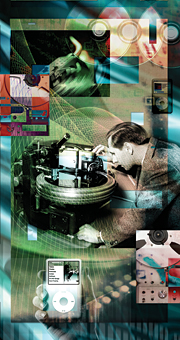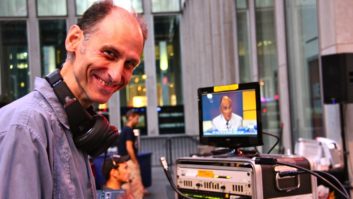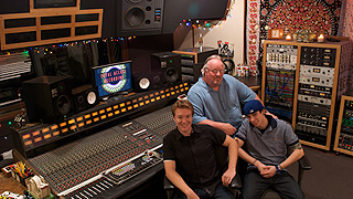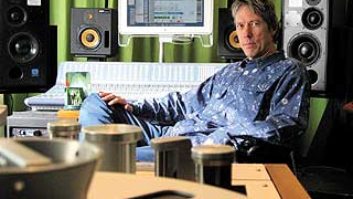
Illustration: Kay Marshall
These Days, Masterjavascript:preview_media(24428)ing isn’t just about Golden Ears: The role of the mastering engineer has become more consultative as artists pursue multiple release formats for their albums. Enthusiasm for vinyl has spread anew among artists who are frustrated with the sonic shortcomings of MP3. At the same time, a burgeoning interest in optimizing material for all available, and even future, formats is beginning to emerge.
San Francisco-based mastering engineer Paul Stubblebine describes the ways he has expanded his services: “I realized recently that I have to say we’re mastering for four formats: CD, downloads, vinyl and high-resolution digital. And that’s not including tape, which we’re also doing for our in-house label, The Tape Project.”
It’s not just the existence of these multiple release formats that’s expanding mastering engineers’ roles, however, it’s also the changing profile of their clients. “There are more people with less experience in the music business today,” says Sterling Sound engineer/partner Greg Calbi. “I see more people than ever coming in here who’ve never been in a real recording studio. At the same time, many of these independent artists are more interested in their brand, I think, than artists have been in the past. And they feel there’s a learning curve when it comes to mastering. It’s like we’re filling a kind of void. By coming to us, artists feel they’re getting an important, professional take on what they do.”
Calbi — who owns Sterling with fellow mastering engineers Ted Jensen and Tom Coyne, along with president Murat Aktar — notes, “September ’08 was our highest billing month in the 10 years since we’ve owned the company,” citing a significant growth in Sterling’s international business. Additionally, he points out that, “2008 has also been the best year for vinyl, by far, in those 10 years.”
Revisiting Vinyl
By all accounts, customer interest in the vinyl format has skyrocketed in recent years, most notably among rock bands and artists who hadn’t traditionally released on vinyl for club DJs. Calbi estimates that the number of lacquers cut at Sterling this year is double that of previous years. “Almost everybody who comes to Sterling at least inquires about vinyl; the business just keeps growing exponentially,” he says. “We even picked up a second Neumann lathe from Sony Studios when it closed.”
Ray Janos handles the vinyl cutting at Sterling. “Generally, he cuts from digital copies,” says Calbi. “But we do use 96kHz files when they’re available and when the client is so inclined; we will create a 96k master that won’t have any of that digital compression that the CD would have. Your best bet is to use the highest-resolution file that can be played back through the best D-to-A converter that you have. We use Prism converters that take 96kHz files.”
These days, most records are not so much mastered specifically for vinyl as they are re-purposed for vinyl. “There’s really no difference between how I EQ material for CD or vinyl,” says New York City-based mastering engineer David Kutch, owner of The Mastering Palace. “For me, the most important element in vinyl creation is the person who is going to physically cut the master lacquer. Two different cutting engineers will yield two totally different sonic results. There are engineers who know how to ‘operate’ a lathe and engineers who play it like a musical instrument. The latter is the one who will most faithfully reproduce the essence of the original recording.” Kutch names Rob LoVerde of Mobile Fidelity Sound Lab in Sebastopol, Calif., as his choice cutter.
Doug Sax, owner of The Mastering Lab in Ojai, Calif., and veteran mastering engineer recommends, “You don’t want to cut vinyl from a CD master — that’s just the way to make the worst-sounding vinyl. When the client wants a vinyl cutting master, we re-transfer the album — after everyone’s approved the changes we’re making — at 96kHz/24-bit, with no digital limiting and without pushing the A-to-D converters in any way. We put tones on it and a sidebreak, and send it to someone, preferably Bernie Grundman, who’s set up to do a flat transfer to vinyl, going through a minimum amount of equipment.”
When mastering for CD and vinyl, San Francisco-based engineer Mike Wells sends a dual stream out through his Lavry converters, with “one going into a final stage of limiting for CD and one that doesn’t for vinyl.” Wells then typically sends material to be cut on vinyl to Paul Gold of Salt Mastering in Brooklyn, N.Y.
Gold says he prefers to receive a 24-bit un-peak-limited file but will work with whatever comes in the door. “My job is to get the cleanest possible transfer of the source material so that it will play back relatively distortion-free,” says Gold. “I’ll typically use some high-frequency limiting, de-essing, maybe a lowpass or highpass filter, and an elliptical EQ. But basically what I try to do is figure out a way to do the transfer so that as little of that happens as possible.”
As far as mastering to both CD and vinyl, Gold echoes the practices of Kutch, Sax and Wells, noting, “If I’m mastering the record [for CD], I always cut off a 24-bit un-peak-limited file, but otherwise the master I make for the CD is the same as the master I cut.” Special circumstances do come up, says Gold, where the dual-format mastering is not so seamless. “I’ve mastered records of experimental music, and sometimes there will be elements like superwide stereo bass, which is very difficult to cut onto a record,” he notes. “So I may do two versions of that, but that’s the really odd case.”
When planning for a vinyl release, artists need to count on significant manufacturing time, adds Calbi. “The jacket manufacturers and pressing plants are so overwhelmed now that there’s a huge turnaround time. There’s just more demand than there is supply, especially for high-quality pressing, but even just the raw materials.”
Realities of MP3
As the lowest-quality release format, the lossy-compressed MP3 or AAC audio version of the record will not be the focus of any mastering session. Clients may ask about optimizing for MP3, custom encoding options and the digital distributors who support them, but by and large, the mastering process does not deepen, technically, to prepare the material for its inevitable digitization.
“There is a conversation, sometimes, about how to optimize for MP3, but it’s really not part of the mastering process for me,” says Calbi, “because I don’t want to master for a dumbed-down file. I master for 16-bit/44.1.”
Stubblebine shares, “We don’t really do a separate mastering for MP3s, but assuming the CD is going to be used as a source for the MP3 or AAC file, my main consideration is that what makes it sound good for the CD makes it sound good for the download, as well.
“The biggest thing we can do to make sure the download sounds as good as possible is to resist the temptation to squeeze it too hard,” Stubblebine continues. “Once everything gets squeezed into the top 2 dB of the dynamic range, when you turn that into an MP3 or an AAC, what comes out pretty much sounds like noise. But if you can leave a little bit of dynamics in it, then even the lossy-compressed version sounds more musical.”
While artists, producers and certainly mastering engineers may be interested in some higher-quality digital format, the distribution channels for a higher-resolution digital download are just not there yet for the mainstream music market. Wells has been “kicking the tire of digital distribution and fidelity of digital assets” for the past five years, even researching and writing on the topic. Finally, this year, he’s seeing clients take an active interest in their digital assets and how they can optimize sound quality and find distributors who at least accept custom-encoded audio files, a process he promotes on his Website (www.mikewellsmastering.com) as “codec mastering.”
“Awareness seems to be coming around, where clients will ask me if I can provide them with a high-quality digital asset that’s compatible in the marketplace,” says Wells. “I use the LAME encoder to create assets that are extremely compatible with players in the marketplace. There is also the free AAC codec, which is also very good for doing an AAC packet format. I use MP3 tag as my tagger application and then you’re covering both bases so you have a nice digital asset format, fully tagged.”
Many digital distributors do not allow artists to submit encoded assets directly, and instead follow a batch-encoding process using submitted CDs. “iTunes used to allow you to submit your assets directly, but they stopped because it required too much QA,” Wells informs. “Apparently, they’re making exceptions for the larger artists and charging a fee. But this is what I see as the independent artist’s biggest bottleneck at the moment. They can come to me to get better-sounding digital assets, but then they run into problems getting it out into the marketplace.”
Wells notes that the M/S monitoring feature of his Dangerous Music transfer console has been particularly useful in mastering digital files. “I do a lot of work on the CD-mastering side in M/S, and I wondered whether I could deliver better results in the digital asset realm in M/S and I’m finding that I can,” Wells reports. “You do the encoding separately and then stitch the file back together, and it actually seems to sound much better. You can do dedicated encodings in M/S and reassemble your stereo from there.”
Formats of the Future
In the post-SACD and DVD-A world, mastering engineers and audio enthusiasts wonder what will emerge as the most viable high-resolution digital release format. “There is a really weird blip in the business right now,” says Calbi. “People are coming up here all the time with 96kHz and 88.2 files, and we could process them and deliver them that way if anyone wanted them, if there was any way they could be distributed.”
Stubblebine works for a number of audiophile labels, including Reference Recordings, which recently started selling DVD-R releases containing music as 176kHz/24-bit WAV files. “At the end of the mastering session, we come out with a CD master and, starting about a year ago, file sets for high-res release for the clients who want it,” Stubblebine describes. “In addition to the 176kHz/24-bit WAV files for reference, we also made a 96kHz/24-bit version of the tracks for a new download site the Cheskys launched called HD Tracks (www.hdtracks.com). So it’s a project mastered for 176 kHz, 96 kHz and CD release. We’ll make whatever it is they need, and what they need depends on where it’s going.”
Assuming the mainstream music market develops some high-res digital-distribution channels, mastering engineers may soon be delivering multiple digital release formats. Stubblebine assures, however, “It doesn’t add too much more work or cost much more for the client to ask for two more formats because you’ve done most of the work getting up to the point where you have a finished, edited, EQ’d and mastered 176kHz file, and then it’s just incremental work to repurpose to the CD master, the 176 master, the 96 master.”
The high-res releases from major labels that would really spark consumer interest could be years away, however, as Calbi speculates. “Because we all work in 16-bit/44.1 in terms of delivery, the engineers here don’t have copies of material mastered over the past several years in high resolution,” he explains. “So if they wanted to re-release an album by a legacy artist, the labels would have to go back and remaster, which would take a real commitment and investment. Because they don’t have the money, we’re stuck in that in-between period, where the technology can do it but the business plan doesn’t make any sense.”
Instead of coming from the larger recording industry, that commitment is being demonstrated by the efforts of individuals. Doug Sax and Bill Schnee introduced a new 2-track digital recording format at AES. “We recorded a jazz group and a small rock group direct to 2-track at 192kHz/24-bit using these new A/D and D/A converters made by JCF Audio,” says Sax, who along with Schnee, originally pioneered direct-to-disc recording with releases on his Sheffield Lab audiophile label. “We wanted to see if there was any interest and if people heard any of the merits that we heard in making it. We feel this is our purpose now — to try and explore what can be done. It was very well-received.”
Producer T Bone Burnett is another emerging figure in the movement to improve digital audio. His new CODE technology, which he described in Mix‘s October issue as “a quality-control system,” will provide a set of standards for digital audio that would work to optimize sound for every file format.
Controlling the Process
Eager to deliver elevated music experiences but frustrated by the mandate to compensate for inferior production quality while meeting commercial demands, Paul Stubblebine Mastering, Sterling Sound and Bernie Grundman Mastering have all started in-house record labels. Stubblebine held a forum on this trend at AES ’08. “I wondered, what is it that’s making us want to start labels that are all so different from what the mainstream music business looks like,” says Stubblebine. “I think we all feel, without dwelling on the negative, that the whole idea of making smaller and smaller files for file sharing hasn’t really moved us in the right direction so we’ve looked for other ways of working.”
Stubblebine’s Tape Project produces reel-to-reel releases, Sterling’s Experience Vinyl deals in vinyl and Grundman’s Straight Ahead Records takes a natural approach — live recording and mixing using proprietary electronics for optimizing quality (a system that reportedly uses less overall electronics than any other).
“We’re all operating off the same impulse — to allow the home listener to hear music at the kind of quality level we hear it at in the studio,” says Stubblebine, “without the distractions of what comes from compressing the stuff down to MP3 and AAC — that lack of resolution that, for many of us, is just not enough.”
The in-house labels give these mastering engineers the opportunity to focus wholly on sound quality without pressure to push the levels at the expense of dynamics. The Straight Ahead releases, explains Grundman, “are live-to-2-track and mixed right on the spot, using all custom-built equipment in the signal path. We use a special equalizer that has almost no electronics in it. We’ve carefully selected each piece of equipment in the chain according to what has the most natural, cleanest sound.” Neil Larsen’s group, Orbit, featuring Robben Ford, recently released a Straight Ahead record as a double-vinyl LP and an Emerald Audiophile Series CD. The sound quality of this CD, made with a dark-green polycarbonate that enables a more accurate reading of the digital data from the disc, reportedly “rivals the vinyl.”
Mastering a Tape Project release follows the flow of any other mastering session, says Stubblebine. “We’ll get the master tape up, run it through our chain, and once we’ve got it optimized we’ll run that twice to the 1-inch, 2-track. We’ll edit those together and we’ll have reel A and reel B running masters. In some cases, it requires quite a bit of EQ, and in others, none whatsoever, and we’ll just do a straight connection. The major difference is in our approach because we know we’re mastering for people that have decent or great stereo systems, so there’s no question of compromising the sound quality.”
Of Experience Vinyl, Calbi says, “We wanted to do something that would promote the studio in terms of our commitment to good sound. It’s so rare to have a tape that you can put on a machine and transfer to a piece of acetate and send it to a plant, but we found one that we’re releasing by an artist named Kim Taylor. It was a beautiful tape and we did a beautiful transfer onto vinyl. It sounds really tactile and rich-sounding. That’s our second release; we also did a blues album by Michael Powers, and we plan on doing more.”
Janice Brown is a freelance writer based in New York City.




